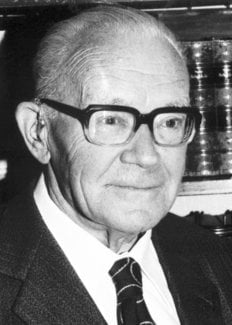Georg Wittig
Biographical
Ttranslation from the German text

Born in Berlin in 1897. Doctorate and University Teaching Thesis in Marburg/Lahn from the Faculty of Chemistry. Head of Department at Braunschweig (Technical College) from 1932; Associate Professor at Freiburg/Brsg. from 1937; Professor and Faculty Director at the Institute of Chemistry, Tübingen, from 1944; turned down the same position as successor to H. Staudinger at Freiburg/Brsg.; accepted the same position at Heidelberg as successor to K. Freudenberg. Professor Emeritus since 1967.
Scientific Activities
Textbook on stereochemistry, 1930. Papers on the subject of ring tension and double bonds as well as valency tautomerism. Main research into organic reactions of alkali metals and elaboration of carbon-based chemistry. Discovery of the halogen-metal exchange reaction (simultaneously with H. Gilman). Development of ylide chemistry and, together with that, study of the Stevens and Sommelet rearrangements as well as intra-anionic ether isomerisation. Through the synthesis of the pentaaryl derivatives of the elements of group 5, the phosphorous ylides were discovered and also, in 1953, the carbonylolefins which have since proven to be crucial for the manufacture of synthetic fabrics and also important in other industrial processes. In 1942 dehydrobenzol was proven to be a shortlived by-product, a fact demonstrated bye. D. Roberts in 1953 and by me, only this time using different means, viz. control experiments on Diels – Alder adducts. More recently the concept of the “at”-complexes as a counterpart to the “onium” complexes has led to the development of a new chemistry from which have come the sodium tetra phenylborates.
Honours
Honorary Doctorate from the Sorbonne in 1957; Honorary Doctorate from the Universities of Tübingen and Hamburg in 1962; Adolf von Baeyer Memorial Medal from the German Chemical Society in 1953; Silver Medal from the University of Helsinki in 1957; Dannie Heinemann Award from the Göttingen Academy of Sciences in 1965; Otto Hahn Award for Chemistry and Physics in 1967; Silver Medal from the City of Paris in 1969; Paul Karrer Medal from the University of Zurich in 1972; Médaille de la Chaire Bruylants (University of Louvain) in 1972; Roger Adams Award from the American Chemical Society in 1973; Karl Ziegler Prize in 1975; Honorary Member of the Swiss Chemical Society in 1963; Honorary Member of the New York Academy of Sciences in 1965; Member of the Chemical Society of Peru, also in 1965; Honorary Fellow of the Chemical Society (London) in 1967; Member of the French Academy in 1971; Member of the Society of Medical Sciences, Córdoba (Argentina), in 1976. As well as these, member of several German academies: Bavarian Academy of Sciences, Heidelberg Academy of Sciences, German Academy of the Natural Scientist Leopoldina Halle.
This autobiography/biography was written at the time of the award and first published in the book series Les Prix Nobel. It was later edited and republished in Nobel Lectures. To cite this document, always state the source as shown above.
Georg Wittig died on 26 August 1987.
Nobel Prizes and laureates
Six prizes were awarded for achievements that have conferred the greatest benefit to humankind. The 12 laureates' work and discoveries range from proteins' structures and machine learning to fighting for a world free of nuclear weapons.
See them all presented here.
